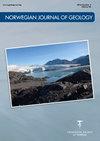求助PDF
{"title":"芬诺斯坎迪亚全新世早期古地震引起的潜在次生事件——气候相关综述","authors":"O. Eldholm, H. Bungum","doi":"10.17850/NJG101-2-3","DOIUrl":null,"url":null,"abstract":"© Copyright the authors. This work is licensed under a Creative Commons Attribution 4.0 International License. During the last deglaciation of Fennoscandia, large earthquakes may have induced secondary effects on the high-latitude coastal regions and continental margins primarily from surface rock avalanches, large and small submarine slides, local and regional flooding, and tsunamis. In this overview, we show that the climate-earthquake-slide-tsunami causal sequence is particularly important, as is structural inheritance and rejuvenation. However, there are potential earthquake-generating early Holocene faults also beyond the previously defined Lapland Fault Province. Thus, we introduce the term the Greater Lapland Fault Province. Earthquakes in the expanded fault province are candidates for triggering the 8.1 ka Storegga Megaslide and/or its predecessors and coeval tsunamis. The events might have released other submarine slides, gas hydrate expulsion leaving large pockmark fields and rock avalanches and submarine mass wasting in fjord and lake settings. Moreover, seismic events may also have triggered local and regional flooding by breakup of ice and sediment barriers.","PeriodicalId":49741,"journal":{"name":"Norwegian Journal of Geology","volume":" ","pages":""},"PeriodicalIF":0.8000,"publicationDate":"2021-06-07","publicationTypes":"Journal Article","fieldsOfStudy":null,"isOpenAccess":false,"openAccessPdf":"","citationCount":"1","resultStr":"{\"title\":\"Potential secondary events caused by early Holocene paleoearthquakes in Fennoscandia – a climate-related review\",\"authors\":\"O. Eldholm, H. Bungum\",\"doi\":\"10.17850/NJG101-2-3\",\"DOIUrl\":null,\"url\":null,\"abstract\":\"© Copyright the authors. This work is licensed under a Creative Commons Attribution 4.0 International License. During the last deglaciation of Fennoscandia, large earthquakes may have induced secondary effects on the high-latitude coastal regions and continental margins primarily from surface rock avalanches, large and small submarine slides, local and regional flooding, and tsunamis. In this overview, we show that the climate-earthquake-slide-tsunami causal sequence is particularly important, as is structural inheritance and rejuvenation. However, there are potential earthquake-generating early Holocene faults also beyond the previously defined Lapland Fault Province. Thus, we introduce the term the Greater Lapland Fault Province. Earthquakes in the expanded fault province are candidates for triggering the 8.1 ka Storegga Megaslide and/or its predecessors and coeval tsunamis. The events might have released other submarine slides, gas hydrate expulsion leaving large pockmark fields and rock avalanches and submarine mass wasting in fjord and lake settings. Moreover, seismic events may also have triggered local and regional flooding by breakup of ice and sediment barriers.\",\"PeriodicalId\":49741,\"journal\":{\"name\":\"Norwegian Journal of Geology\",\"volume\":\" \",\"pages\":\"\"},\"PeriodicalIF\":0.8000,\"publicationDate\":\"2021-06-07\",\"publicationTypes\":\"Journal Article\",\"fieldsOfStudy\":null,\"isOpenAccess\":false,\"openAccessPdf\":\"\",\"citationCount\":\"1\",\"resultStr\":null,\"platform\":\"Semanticscholar\",\"paperid\":null,\"PeriodicalName\":\"Norwegian Journal of Geology\",\"FirstCategoryId\":\"89\",\"ListUrlMain\":\"https://doi.org/10.17850/NJG101-2-3\",\"RegionNum\":4,\"RegionCategory\":\"地球科学\",\"ArticlePicture\":[],\"TitleCN\":null,\"AbstractTextCN\":null,\"PMCID\":null,\"EPubDate\":\"\",\"PubModel\":\"\",\"JCR\":\"Q2\",\"JCRName\":\"Earth and Planetary Sciences\",\"Score\":null,\"Total\":0}","platform":"Semanticscholar","paperid":null,"PeriodicalName":"Norwegian Journal of Geology","FirstCategoryId":"89","ListUrlMain":"https://doi.org/10.17850/NJG101-2-3","RegionNum":4,"RegionCategory":"地球科学","ArticlePicture":[],"TitleCN":null,"AbstractTextCN":null,"PMCID":null,"EPubDate":"","PubModel":"","JCR":"Q2","JCRName":"Earth and Planetary Sciences","Score":null,"Total":0}
引用次数: 1
引用
批量引用
Potential secondary events caused by early Holocene paleoearthquakes in Fennoscandia – a climate-related review
© Copyright the authors. This work is licensed under a Creative Commons Attribution 4.0 International License. During the last deglaciation of Fennoscandia, large earthquakes may have induced secondary effects on the high-latitude coastal regions and continental margins primarily from surface rock avalanches, large and small submarine slides, local and regional flooding, and tsunamis. In this overview, we show that the climate-earthquake-slide-tsunami causal sequence is particularly important, as is structural inheritance and rejuvenation. However, there are potential earthquake-generating early Holocene faults also beyond the previously defined Lapland Fault Province. Thus, we introduce the term the Greater Lapland Fault Province. Earthquakes in the expanded fault province are candidates for triggering the 8.1 ka Storegga Megaslide and/or its predecessors and coeval tsunamis. The events might have released other submarine slides, gas hydrate expulsion leaving large pockmark fields and rock avalanches and submarine mass wasting in fjord and lake settings. Moreover, seismic events may also have triggered local and regional flooding by breakup of ice and sediment barriers.


